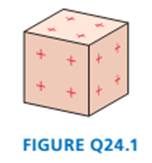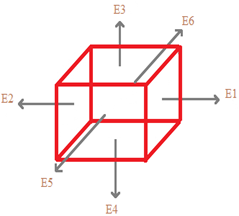
Concept explainers
Suppose you have the uniformly charged cube in FIGURE Q24.1. Can you use symmetry alone to deduce the shape of the cube 's electric field? If so, sketch and describe the field shape. If not, why not?

If symmetry alone can be used to deduce the shape of the cube’s electric field.
Explanation of Solution
Given:
The following figure of uniformly charged cube is given.

Using Gauss’s law, we can deduce electric fields, particularly those with a high degree of symmetry, simply from the shape of the charge distribution.
The pattern of the electric field through the surface is like that the shape of the charged body, if the Gaussian surface matches the symmetry of the charge dispersion inside. For a consistently charged dispersion, the shape of the Gaussian surface coincides with the shape of the electric field. So, the shape of the electric field is cubical in nature for a consistently charged cube shape that is the electric field at each point on the face of a solid shape is comparative and its direction is perpendicular to the face cube. The sketch of the electric field through each face of the consistently charged cube is appeared as follows.

Conclusion:
We can use the symmetry alone to predict the shape of the electric field, the electric field in each face of the cube will have the same magnitude and perpendicular to that face.
Want to see more full solutions like this?
Chapter 24 Solutions
PHY F/SCIENTIST MOD MASTERING 24 MO
Additional Science Textbook Solutions
Biology: Life on Earth (11th Edition)
Campbell Biology (11th Edition)
Chemistry: A Molecular Approach (4th Edition)
Chemistry: An Introduction to General, Organic, and Biological Chemistry (13th Edition)
Chemistry
Microbiology: An Introduction
- No chatgpt plsarrow_forwardIn a naval battle, a battleship is attempting to fire on a destroyer. The battleship is a distance d1 = 2,150 m to the east of the peak of a mountain on an island, as shown in the figure below. The destroyer is attempting to evade cannon shells fired from the battleship by hiding on the west side of the island. The initial speed of the shells that the battleship fires is vi = 245 m/s. The peak of the mountain is h = 1,840 m above sea level, and the western shore of the island is a horizontal distance d2 = 250 m from the peak. What are the distances (in m), as measured from the western shore of the island, at which the destroyer will be safe from fire from the battleship? (Note the figure is not to scale. You may assume that the height and width of the destroyer are small compared to d1 and h.)arrow_forwardNo chatgpt plsarrow_forward
- The law of reflection applies to Question 14Select one: a. specular reflection b. irregular reflection c. All of these d. diffuse reflectionarrow_forwardAccording to your book "normal" human body temperature is considered to be ________? Select one: a. none of these b. 98.6°C c. 37°C d. 100°Carrow_forwardProblem Seven. A football receiver running straight downfield at 5.60 m/s is 11.5 m in front of the quarterback when a pass is thrown downfield at an angle of 35.0° above the horizon. 8.) If the receiver never changes speed and the ball is caught at the same height from which it was thrown, find the distance between the quarterback and the receiver when the catch is made. (A) 21.3 (B) 17.8 (C) 18.8 (D) 19.9 (E) 67.5arrow_forward
- When two bar magnets are near each other, the north pole of one of the magnets experiences what type of force from the other magnet? 1. both an attractive force and a repulsive force 2. a Coulomb force 3. only an attractive force 4. only a repulsive forcearrow_forwardWhat can be said about the electric force between two charged particles? It varies as 1/r. It depends only on the magnitudes of the charges. It is much, much greater than the attractive gravitational force. It is repulsive for unlike charges.arrow_forwardA piece of copper originally 305mm long is pulled in tension with a stress of 276MPa. If the deformation is elastic, what will be the resultant elongation. E for copper is 110Gpaarrow_forward
- Please solve and answer the problem correctly please. Be sure to give explanations on each step and write neatly please. Thank you!!arrow_forwardIn the figures, the masses are hung from an elevator ceiling. Assume the velocity of the elevator is constant. Find the tensions in the ropes (in N) for each case. Note that 0₁ = 35.0°, 0₂ = 55.0°, 03 = 60.0°, m₁ = 3.00 kg, and m2 = 7.00 kg. (Due to the nature of this problem, do not use rounded intermediate values-including answers submitted in WebAssign-in your calculations.) (a) Τι WY NY MY T3 e₁ T₁ = N = N = N (b) 18 Τι = Τι T3 = || || || = T T Ts m₂ N N N 02 T₂ T3 m₁arrow_forwardYou are working with a movie director and investigating a scene with a cowboy sliding off a tree limb and falling onto the saddle of a moving horse. The distance of the fall is several meters, and the calculation shows a high probability of injury to the cowboy from the stunt. Let's look at a simpler situation. Suppose the director asks you to have the cowboy step off a platform 2.55 m off the ground and land on his feet on the ground. The cowboy keeps his legs straight as he falls, but then bends at the knees as soon as he touches the ground. This allows the center of mass of his body to move through a distance of 0.660 m before his body comes to rest. (Center of mass will be formally defined in Linear Momentum and Collisions.) You assume this motion to be under constant acceleration of the center of mass of his body. To assess the degree of danger to the cowboy in this stunt, you wish to calculate the average force upward on his body from the ground, as a multiple of the cowboy's…arrow_forward
 Physics for Scientists and Engineers: Foundations...PhysicsISBN:9781133939146Author:Katz, Debora M.Publisher:Cengage Learning
Physics for Scientists and Engineers: Foundations...PhysicsISBN:9781133939146Author:Katz, Debora M.Publisher:Cengage Learning Principles of Physics: A Calculus-Based TextPhysicsISBN:9781133104261Author:Raymond A. Serway, John W. JewettPublisher:Cengage Learning
Principles of Physics: A Calculus-Based TextPhysicsISBN:9781133104261Author:Raymond A. Serway, John W. JewettPublisher:Cengage Learning Physics for Scientists and Engineers with Modern ...PhysicsISBN:9781337553292Author:Raymond A. Serway, John W. JewettPublisher:Cengage Learning
Physics for Scientists and Engineers with Modern ...PhysicsISBN:9781337553292Author:Raymond A. Serway, John W. JewettPublisher:Cengage Learning Physics for Scientists and EngineersPhysicsISBN:9781337553278Author:Raymond A. Serway, John W. JewettPublisher:Cengage Learning
Physics for Scientists and EngineersPhysicsISBN:9781337553278Author:Raymond A. Serway, John W. JewettPublisher:Cengage Learning College PhysicsPhysicsISBN:9781305952300Author:Raymond A. Serway, Chris VuillePublisher:Cengage Learning
College PhysicsPhysicsISBN:9781305952300Author:Raymond A. Serway, Chris VuillePublisher:Cengage Learning




